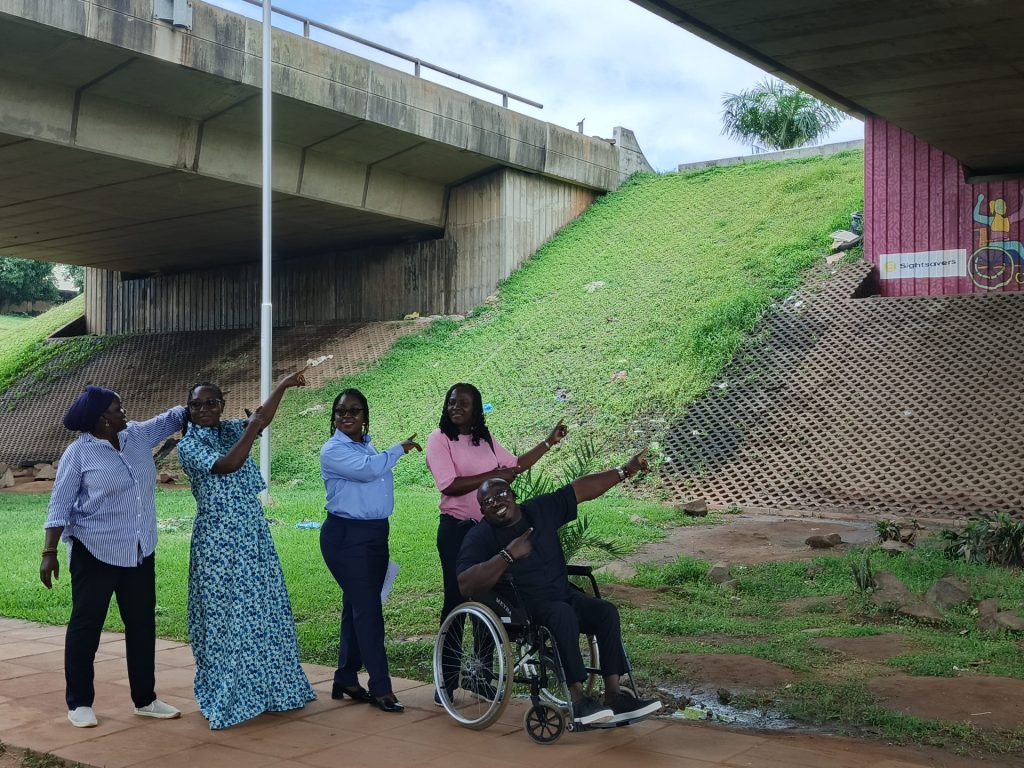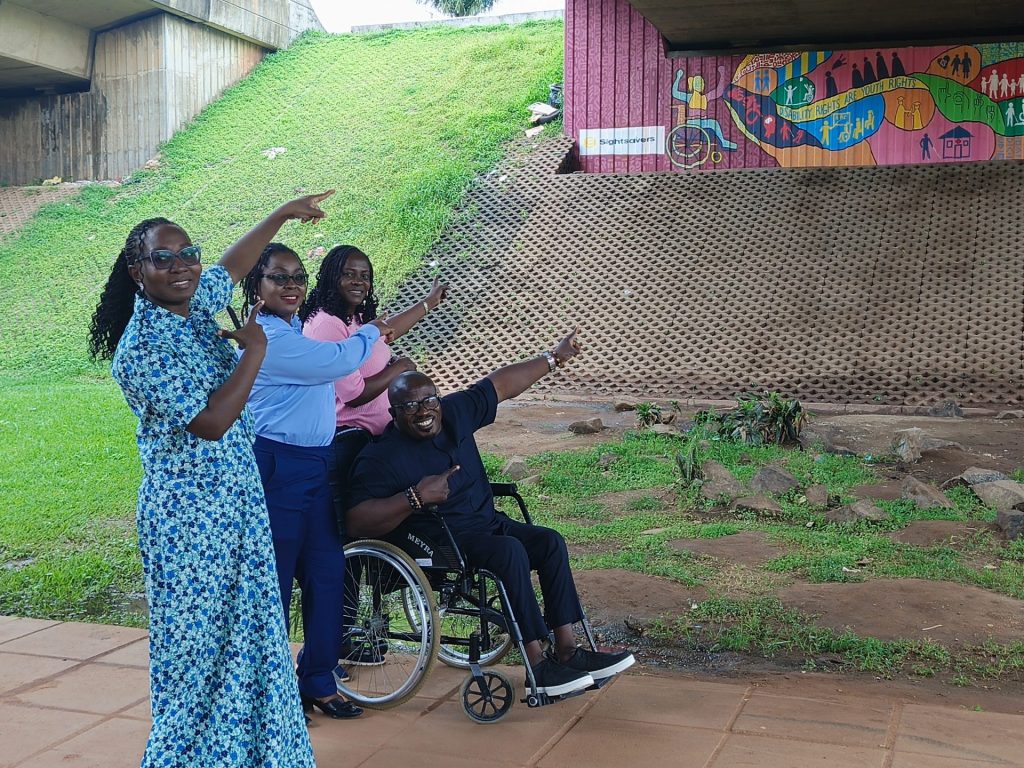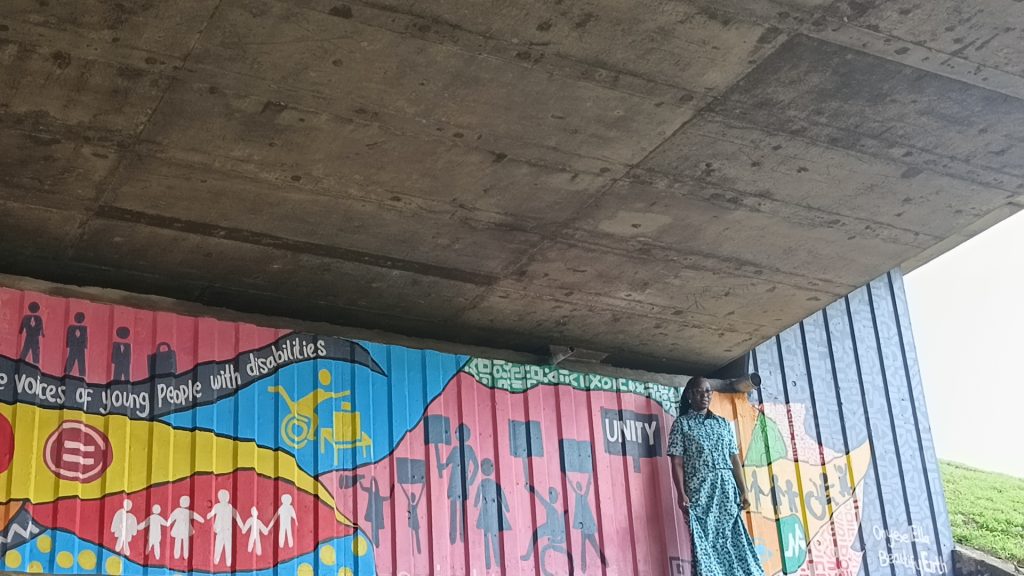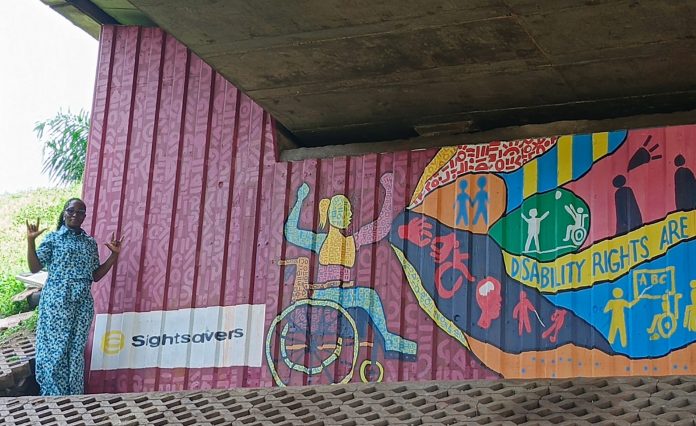Abuja, Nigeria – A bold and vibrant mural has been unveiled in the heart of Abuja, sparking a call to action for global leaders to prioritize the rights and inclusion of persons with disabilities. Located at the bustling Garki Area 1 roundabout, the mural is the latest installation in an international campaign aimed at highlighting the voices of young people with disabilities in the fight for inclusion. Created by renowned Abuja-based artist Ella Onyebe, the artwork is part of a global initiative spearheaded by the international development organization Sightsavers.
This mural, which features a young woman in a wheelchair surrounded by vivid, colorful speech bubbles that symbolize advocacy and social inclusion, serves as a powerful visual statement. The bubbles emanating from her form a dynamic representation of youth advocacy, each illustrating the importance of social inclusion, equal opportunities, and the fight for the rights of persons with disabilities.
The unveiling of the artwork comes at a critical time as world leaders prepare to gather for the United Nations (UN) Summit of the Future in New York. The summit is set to reinvigorate global efforts toward achieving the Sustainable Development Goals (SDGs), which include eliminating poverty and ensuring equality for all. Sightsavers’ Equal World campaign, which commissioned the mural, is advocating for the inclusion of youth with disabilities in these vital discussions and decision-making processes.




A Global Movement for Disability Inclusion
The mural in Abuja is one of four commissioned by Sightsavers as part of a global campaign to raise awareness about disability rights and inclusion. Similar murals have been unveiled in New York, USA; Homa Bay, Kenya; and Dakar, Senegal. Each of these murals carries a common message: persons with disabilities, especially young people, must not be left behind in the global fight to end poverty and achieve the SDGs.
Dr. Joy Shu’aibu, Country Director of Sightsavers Nigeria, emphasized the urgency of the campaign in her remarks at the mural’s unveiling. “The future belongs to young people,” she said. “Unfortunately, we see that they are often overlooked in the very discussions about plans and policies that directly affect that future. This mural is more than just art; it is a call to action. It reminds us that disability inclusion is not a luxury, but a necessity for achieving the Sustainable Development Goals. We must ensure that persons with disabilities are active participants in shaping the policies that affect their lives.”
Shu’aibu’s comments underscored a critical point: while the world makes strides in various areas of development, persons with disabilities—who are among the most marginalized populations globally—continue to face significant barriers to accessing education, employment, and essential services. According to the UN, youth with disabilities are twice as likely as their peers without disabilities to be excluded from employment, education, or training. This exclusion perpetuates cycles of poverty and inequality, which initiatives like the Equal World campaign seek to break.
A Personal and Powerful Statement from the Artist
For Ella Onyebe, the artist behind the Abuja mural, the project holds personal significance. As an artist with a disability herself, she knows all too well the barriers faced by people with disabilities in society. Speaking at the unveiling, Onyebe explained that the mural’s message is one she hopes will challenge societal perceptions and prompt more action toward disability inclusion.
“As an artist with a disability, this project is close to my heart for its message and the influence it could have on public perception of disability rights,” Onyebe said. “I believe inclusion is at the heart of a vibrant society, and I hope this mural serves as a visual reminder that everyone, regardless of ability, has a valuable contribution to make and must be given the chance to do so.”
Onyebe’s powerful imagery—a young woman using her voice to advocate for herself and others—captures the essence of what the global campaign aims to achieve. It serves as a testament to the fact that persons with disabilities, particularly young people, have a critical role to play in shaping their futures. The mural is not just a work of art but a public declaration that the inclusion of all people is key to building a better, more equitable world.
International Murals Echo a Shared Message
Abuja’s mural is part of a larger tapestry of advocacy efforts unfolding across the globe. Each of the four murals commissioned by Sightsavers carries a distinct but interconnected message of disability inclusion and empowerment.
In New York, a mural situated near the UN building features a line of young people with and without disabilities standing together, holding signs that call for equality and inclusion. The artwork’s powerful slogan, “Youth Lead the Way to a Better Future,” is a reminder to the global community that the energy and ideas of young people are central to overcoming inequality.
In Homa Bay, Kenya, a mural on the wall of a primary school depicts a young female student with an open book, surrounded by other children and youth with disabilities participating in learning and sports. This mural symbolizes the importance of inclusive education as a cornerstone of development and empowerment.
Similarly, in Dakar, Senegal, a mural features a young girl with vision impairments alongside visual representations of social inclusion themes, calling for an end to the systemic exclusion faced by people with disabilities.
Each mural has been designed to invite public interaction, with spaces where viewers can engage with the artwork and reflect on the importance of inclusion. These interactive elements are intended to foster conversations and inspire action among local communities, government officials, and international leaders alike.
A Call to Action
As the world prepares for the upcoming UN Summit of the Future, the message conveyed through these murals is clear: achieving the SDGs will require deliberate and sustained efforts to include persons with disabilities in all aspects of decision-making and development. Sightsavers and its partners are calling on global leaders to make disability inclusion a priority, not only at the summit but in the policies and frameworks that will shape the world’s future.
The murals stand as symbols of hope and determination, urging societies to create spaces where everyone, regardless of ability, can thrive. By making inclusion a central pillar of global development, the international community can ensure that no one is left behind in the quest for a more just and equitable world.
For Sightsavers, this is more than a campaign—it is a movement that seeks to reshape how the world approaches disability rights. The Abuja mural, along with its counterparts around the globe, is a powerful reminder that art has the ability to challenge perceptions, spark conversations, and inspire change. And as world leaders convene in New York, they will be reminded that the voices of young persons with disabilities must be heard loud and clear.
About Sightsavers
Sightsavers is an international organization working across more than 30 low- and middle-income countries to combat avoidable blindness, treat neglected tropical diseases, and promote the rights of people with disabilities. Through its campaigns and partnerships with governments, Sightsavers aims to create a world where people with disabilities can access health care, education, and employment free from discrimination.
For more information, visit www.sightsavers.org.


